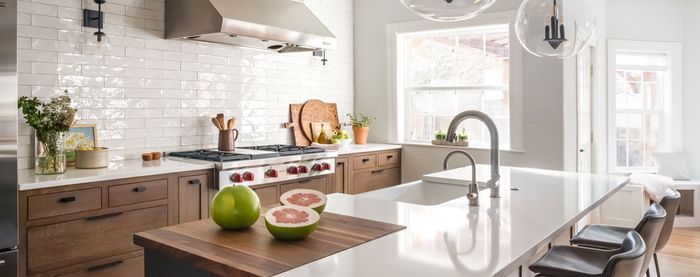Durable Flooring for Kitchens (and Baths)
This survey of sturdy, stylish, and sustainable options looks at price per sq.ft., maintenance requirements, and installation considerations to help you choose the material that best fits your needs.
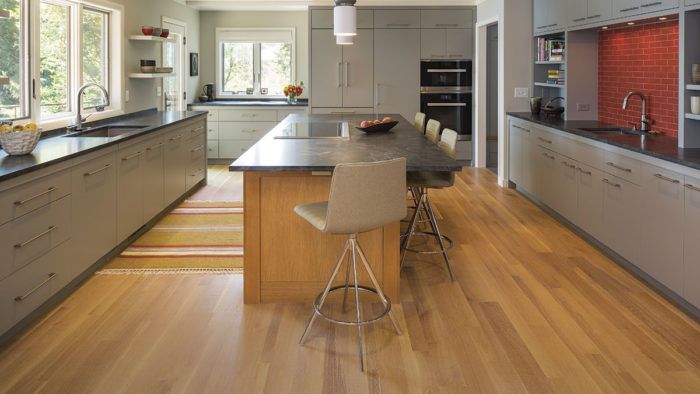
Synopsis: This article walks through the different flooring options for kitchens and baths, including wood and engineered wood, bamboo, ceramic and porcelain tile, cement, vinyl tile, linoleum, natural stone, and terazzo. The author lists approximate prices per square foot for each material, the pros and cons of each, and when they are best applied to a kitchen or bath.
When you’re considering flooring options for your new kitchen or bath, it’s important to keep durability high on the list. Wet and heavily traveled, kitchens and baths are tough on floors. They also have a major impact on resale, so you want your floors to be beautiful and to stay that way.
This is one case where you really can have it all. An expanding array of products— some new, some rediscovered—will deliver lasting beauty and performance in the toughest environments.
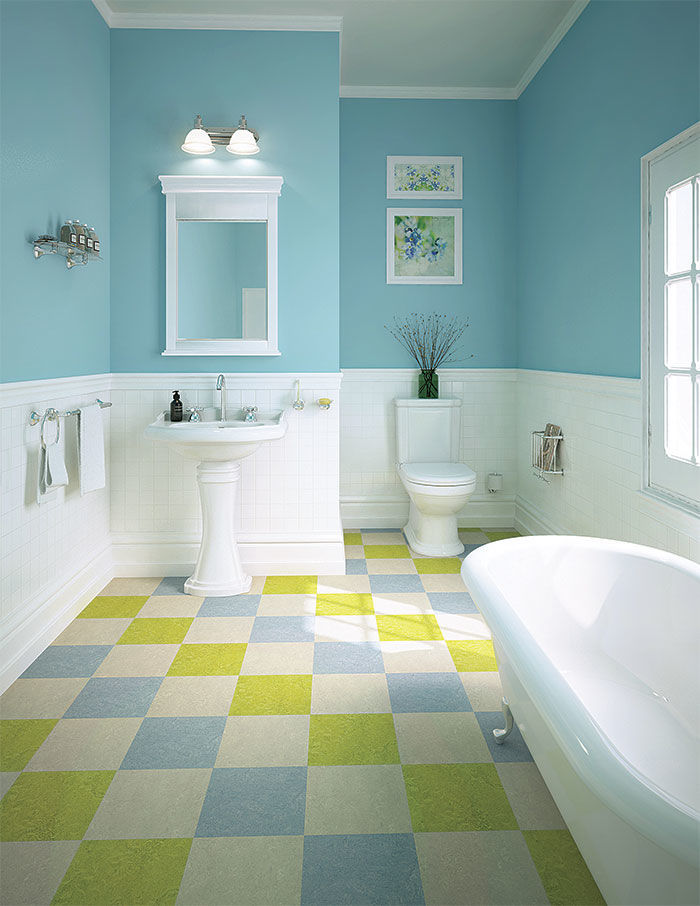 Kitchens and baths are different
Kitchens and baths are different
Despite some similarities in moisture and traffic, kitchens and baths differ in significant ways. Today’s kitchens are often open to adjoining spaces and share a unified look and feel. That’s why hardwood is king in modern kitchens, flowing seamlessly through open floor plans. Minneapolis architect Jean Rehkamp Larson echoes the thoughts of many designers: “If the kitchen is part of a larger room, having a change of flooring material feels like a taped line on the floor.” Wood floors, combined with painted cabinets, create the cozy farmhouse and quiet transitional styles that designers favor.
Finally, compared to tile, wood (as well as bamboo, linoleum, and luxury vinyl tile) is more forgiving to standing cooks and dropped dishes.
If you decide to go with something more waterproof in the kitchen, there are ways to ease the transitions to nearby spaces beyond simply dropping a threshold at the border. “If someone definitely wants a flooring change in the kitchen, I recommend making an architectural or spatial change as well, like changing the ceiling or wall plane or both,” Rehkamp Larson says. This can be as simple as closing an entryway slightly.
The bath, because it’s fully separate, can make its own cohesive design statement. That means flooring materials can be tailored to this unique environment, where kids leave wet towels on the floor and showers create steam and puddles of standing water. Tile is still the most popular option for durable bathroom floors.
Green meets great-looking
Part of the good news about durable, beautiful flooring is a host of healthful, sustainable options. Domestic hardwoods are usually a safe bet, while products such as bamboo, Marmoleum (linoleum), cement tile, and ceramic tile are made from natural materials, usually gathered in responsible ways. All are hypoallergenic and easy to clean
All of the flooring materials featured in this article will look beautiful in a kitchen or bath or both, and they are durable (or repairable) enough to stay that way for decades, though some are better suited to one environment than the other.
To streamline the list, I’ve left out a few materials. Sheet vinyl flooring tends to look plasticky, is difficult to repair, and is rough on resale value, at least for now. Laminate flooring is a low-cost alternative to wood, but its thin, plastic surface film and particleboard or MDF base make it a poor choice for kitchens and baths. Engineered-wood flooring is an excellent alternative. Saltillo tile, made from clay and cured in the sun, is more inconsistent in size and flatness and more porous than other tile; therefore, it is less suitable for kitchen and bath floors.
Be a smart shopper
Quality varies widely in every category, so I leaned toward better-made products when setting price ranges. It’s good to talk to a reputable flooring dealer about the small differences in materials and manufacturing that make a big difference over the long haul.
I’ll offer up additional buying advice in each category, but here are a few general tips. With kitchen and bath flooring, two things matter most: toughness and friction. Materials that are designed for use as flooring will usually check both boxes, but you can drill down through the spec sheets to confirm that.
Glazed ceramic floor tiles are rated for hardness by the Porcelain Enamel Institute, so look for a PEI rating of IV or V. Slips and falls are one of the most common causes of serious injury, especially as we age, so the surfaces of tile and natural stone are also given a friction rating. Look for a dynamic coefficient (DCOF) of 0.42 or greater, or a standard COF of at least 0.60.
With a little research, you’ll get the best of all worlds: beauty, durability, safety, and sustainability. Read on to find the perfect floor for your next kitchen or bath.
Wood and engineered wood
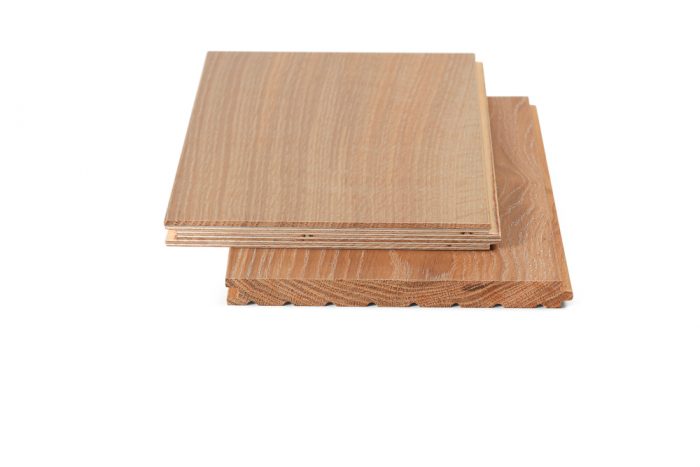
$3 to $12 per sq. ft.
Warm, beautiful, forgiving, durable if maintained; better for kitchen than bath
As the kitchen has evolved from a closed-off cooking room to the center of an open floor plan, wood floors have crept in from nearby spaces, creating a unified look and feel and adding comfort to a room where you will stand for long periods.
While wood is far from waterproof, it will last indefinitely in the kitchen if spills are addressed quickly and the floor is maintained. That said, some builders recommend sheet-metal pans under the dishwasher and fridge, piped to the outdoors or elsewhere, in case there’s a leak or a flood.
The big news in this category is high-quality engineered-wood flooring—a sandwich of solid wood and plywood. Not to be confused with laminate flooring—an image of wood printed on thin plastic—engineered wood’s top layer is solid lumber, meaning nicks or scratches only add charm, not unsightly scars, and the floor can be sanded and refinished to restore its beauty.
An engineered-wood floor offers an array of advantages over solid boards, especially in the kitchen. For one, engineered flooring is usually finished in the factory, which allows a wide array of tones and a more durable wear surface. Second, engineered floors shrink and expand very little, meaning there are little to no gaps between boards and cleanup is easier. Engineered boards also allow wide-plank floors to stay much flatter over time, for a cleaner look. Finally, prices for top-quality engineered flooring are comparable to solid wood. You’ll pay a premium for the factory finish, but it’s a wash when you subtract the cost of sanding and finishing in place. When shopping for engineered flooring, look for a solid-wood layer that’s 1⁄8 in. to 3⁄16 in. thick and glued to a substrate of low-VOC, exterior-grade plywood.
Bamboo
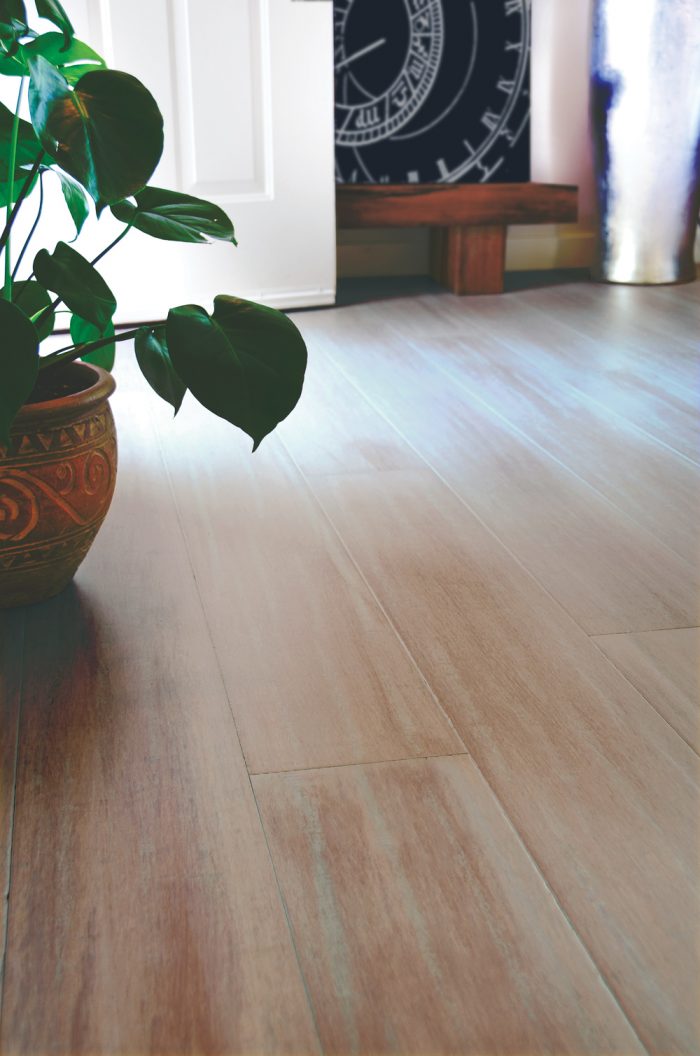
$3 to $7 per sq. ft.
Durable, sustainable, distinctive; better for kitchen than bath
Bamboo flooring is more resistant to water, stains, and warping than hardwood, but it still expands and contracts like wood, so it’s not the best choice for high-humidity environments. If you like bamboo’s natural look, that’s probably a safer choice, as the wide array of colored finishes are very difficult to restore if damaged.
Bamboo is a grass—not a wood—and it grows back quickly after harvesting, so forests are being replaced by bamboo fields in some places.
All bamboo flooring is bonded together with an adhesive, so look for products that are formaldehyde-free and low-VOC, and make sure your bamboo floor can be sanded and refinished (some can’t). Also, avoid bamboo that is carbonized, which can create darker colors but also weakens the material. There is no reliable grading system for bamboo flooring, so go with a reputable manufacturer.
Ceramic/porcelain tile
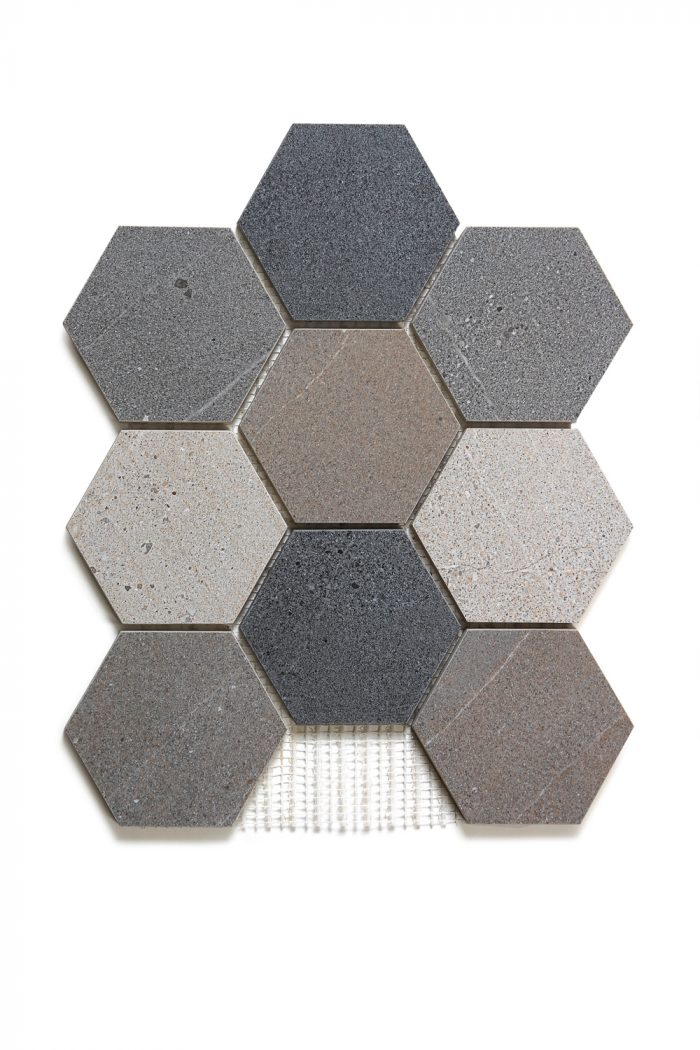
$5 to $20 per sq. ft.
Waterproof, superdurable, and green, with endless design choices
For durability and lasting beauty in the toughest environments, it’s hard to beat high-quality tile, which looks as good in many hundred-year-old homes as the day it was installed. In the ceramic category, there is common ceramic and a harder formulation called porcelain. While ceramic is more affordable, it’s less dense and more porous, requiring a hard surface glaze to protect it. Porcelain, on the other hand, is extremely durable and waterproof and is made with a process that allows almost endless design options, including the look of concrete, wood, or a variety of natural stone, including marble, without any of the maintenance required by those materials.
As colors and looks have proliferated and prices have dropped, porcelain tile has become the material of choice for timeless, durable bathrooms. Large-format porcelain tile is especially popular, creating a clean, sculptural look.
Be aware that some tile labeled porcelain isn’t. Look for the logo of the Porcelain Tile Certification Agency (PTCA) and the words “0.5% water absorption” on the box or spec sheet.
Whatever you choose, tile is labor-intensive to remove, so it pays to buy quality tile and install it correctly. Tile setters like Joshua Oduin of Portland, Ore. look to Italy and Spain for the best ceramic/porcelain tile.
According to Oduin, better-quality tile is more dense, more durable, flatter, and more uniform in thickness and size, allowing thinner grout lines and a flawless final look. Though high-quality tile ages beautifully, grout doesn’t, so experts recommend keeping grout lines on the small side and sealing them well to prevent staining.
Cement tile
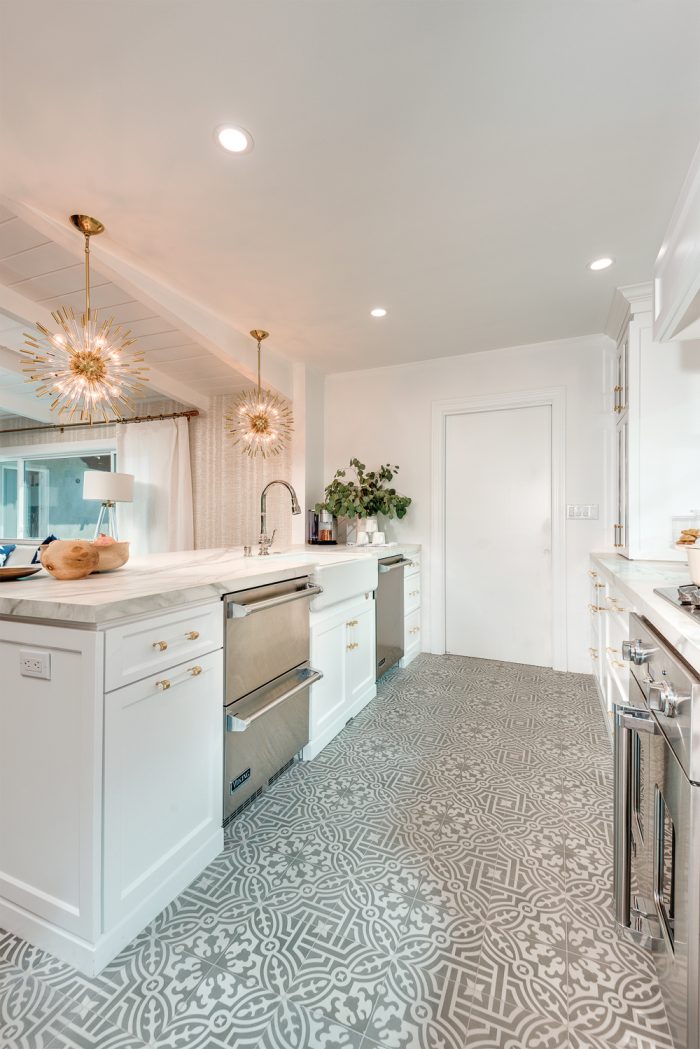
$10 to $18 per sq. ft.
Thick, durable, and nonslip, with crisp, bright patterns; needs regular resealing
Called by many names around the world, from “hydraulic” to “encaustic,” cement tile is one of the hottest trends in flooring. The main attraction is bright colors in ornate patterns that are unmistakably handmade.
To create crisp, colorful motifs in the top layer of the tile, workers pour pigments by hand into a divided mold. From there, a hydraulic press compacts the materials, which are left to cure with no heat required. The materials are durable, and the results are unique: vibrant colors in a matte finish, with no glazing to mask their beauty.
With time and traffic, cement tiles develop an aged patina that only enhances their handmade look. And because the color layer is 1⁄8 in. thick, wear and damage won’t reach below it, and the tiles can be resurfaced if desired, like stone or terrazzo.
Traditional patterns are arranged in groups of four tiles, but more-contemporary designs are being added all the time.
Luxury vinyl tile
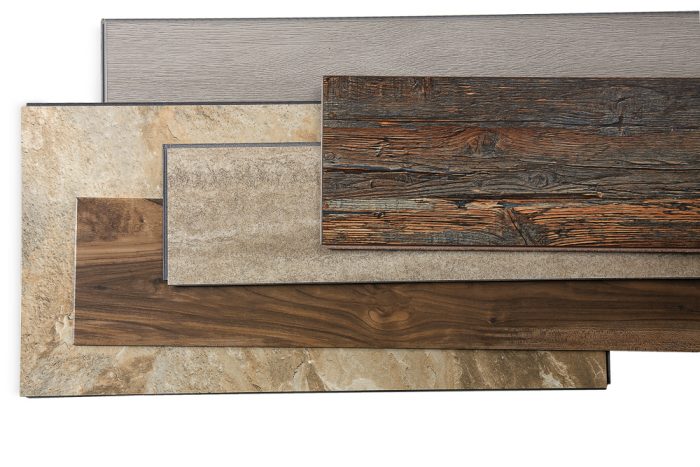
$2 to $7 per sq. ft.
Nearly infinite design options; least expensive flooring option
Luxury vinyl tile (LVT), which is the least expensive kitchen and bath floor, comes in a myriad of styles to suit every taste. Its resilient nature makes it comfortable for hours of standing at the stove and gives dishware a better chance of surviving a drop. Products range from the 1-ft. self-stick squares that have been around for decades to modern-look click-together planks with a built-in sound-deadening underlayment. As with many things, price is often the best indicator of an LVT floor’s expected durability. Look for products with a clear protective layer over a thick wear layer. You can often see the thickness of the wear layer by looking at the side of the tile.
Major manufacturers also give their floors a star rating or a “good, better, best” designation to indicate their respective durability. One of the big benefits of luxury vinyl tile is how quickly it installs compared to tile or unfinished hardwood. Most products can be installed in less than a day and put into service right away or the following day.
Some LVT can be grouted so it looks more like a ceramic floor. Unfortunately, the grout is installed in a thin layer and can be easily damaged, especially when it’s installed over inadequate floor framing. Although modern high-quality products are generally very tough, the biggest downside to LVT is that it’s not as tough as ceramic tile and can’t be refinished like hardwood. Visible damage requires replacement of the individual tile or tiles. Damage can also be caused by running pets or by moving kitchen appliances (or other heavy objects). Keeping the floor clean and discouraging the wearing of shoes inside will help LVT floors look good longer.
Linoleum
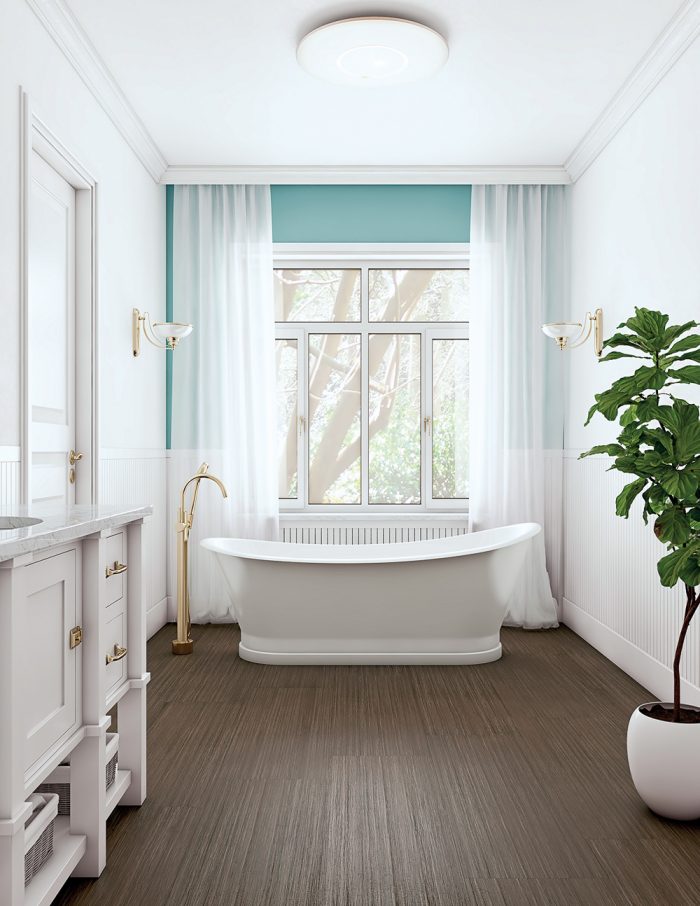
$3 to $6 per sq. ft.
Warm, durable, and green, with brilliant colors
The desire for durable, green products has rekindled interest in classic linoleum, specifically a product called Marmoleum, a version of classic linoleum made by Forbo Flooring Systems in Holland and distributed throughout North America in the form of solid sheets, tiles, and click-lock planks in 100 rich colors and finishes.
Made from natural materials—linseed oil and wood flour on a jute backer—Marmoleum is a sustainably made product that compacts slightly over time and only gets denser and tougher.
The 6-1⁄2-ft.-wide solid sheets create a floor with fewer seams, which is suitable for both kitchens and baths, but they require an experienced linoleum installer who can heat-weld the seams and make edges watertight. Some will also be able to create beautiful custom patterns, pictures, and borders. The tiles and planks, on the other hand, are DIY friendly and can be arranged in patterns of their own. Border pieces are available for click-together flooring, which is thicker than the tiles and sheets and has a cork backer that adds additional give. Although the seams are tight in the click-lock system, it’s not the best for kids’ bathrooms, where standing water and wet towels might be left for long periods.
Natural stone
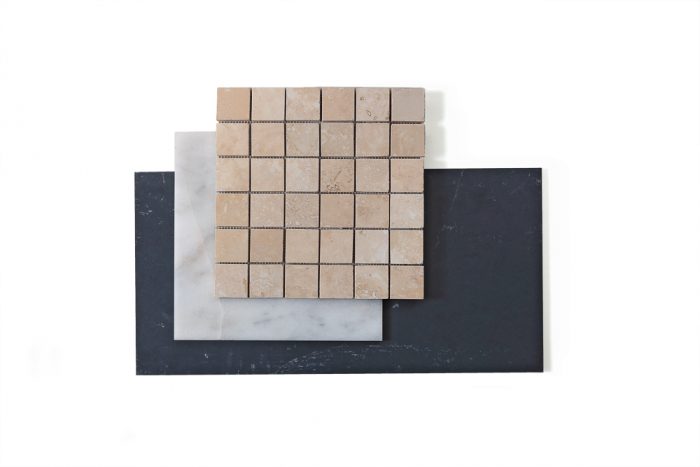
$2 to $30 per sq. ft.
Durable, beautiful, natural; needs regular resealing
Formed over eons, stone comes with a story and offers a connection to where it was quarried—Italy, India, Africa, and beyond. But the soulfulness of stone comes at a price. To prevent staining, stone must be sealed and resealed, and cleaned with specially designed products. Experts also warn that natural stone varies in color, which can differ from what you saw in the showroom. Price, maintenance, and color consistency are why stone-patterned porcelain tile has stolen market share from the real thing.
A wide range of stone tiles are available—slate, granite, marble, travertine, limestone, quartzite, and more—in a wide range of sizes. Be sure to buy stone finished for bathroom floors to avoid slips and falls.
Terrazzo
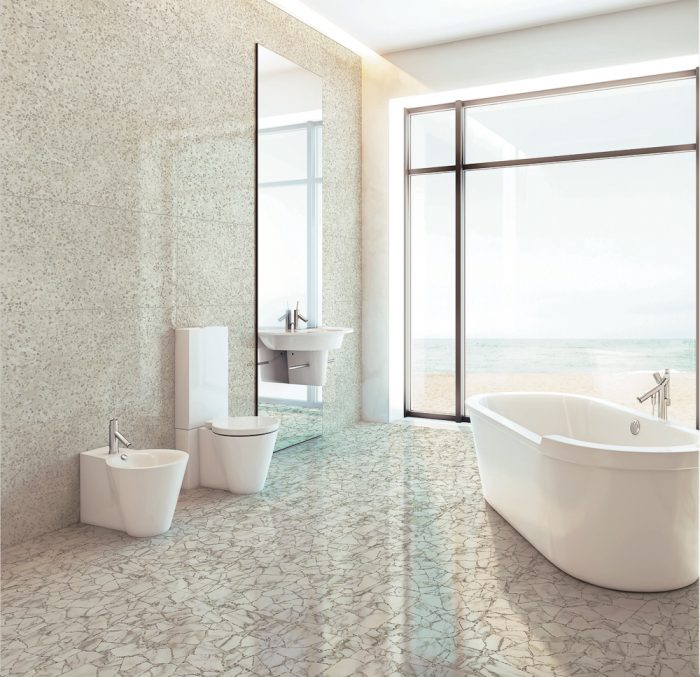
$20 to $50 per sq. ft.
Waterproof, with a 100-year life span if poured in place
Made originally by spreading marble chips on a mortar base, modern terrazzo substitutes epoxy resin for mortar and incorporates a wide variety of aggregate materials. The material is poured in place and then polished after it cures. The epoxy base is more impact-resistant and easier to patch as damage occurs, which is extremely rare. You’ll see terrazzo floors most often in airports and hospitals, where its tough, seamless surface is invaluable.
Terrazzo was at its most popular in midcentury-modern architecture, though it is still prized in vintage homes. If you can afford the high initial cost, and you plan to leave the floor in place for 40 years or more, a terrazzo floor will end up cheaper than the least expensive flooring options.
The benefits of poured terrazzo are many: a seamless, waterproof surface with no grout lines; incredible toughness and durability if installed properly over cement backerboard; and a completely custom look created by colored resin and any number of aggregate types, including marble chips and other stones large and small, as well as inlaid metal strips that allow color changes and custom patterns.
It takes up to 10 years to become a skilled installer of poured terrazzo. To find one near you, consult the website of the National Terrazzo and Mosaic Association (ntma.com). If you can’t find a contractor or you want a similar look for less, consider terrazzo tile, which comes in a variety of sizes and can be installed by any professional tilesetter.
Photos courtesy of Troy Thies; Forbo; Rodney Diaz; Allwood Bamboo; Cement Tile Shop; Patrick McCombe; Armstrong; Nat Rae; and Esmer Tile.
RELATED LINKS
